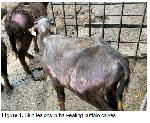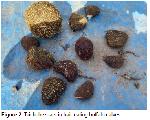Pica is observed in a wide range of animals with multiple forms and it is defined as the abnormal appetite or consumption of substances that do not have any nutritional value
17. Animals with pica may show appetite for non-feedstuff substances such as soil, bones and hair in addition to licking surfaces
18.
This behaviourin buffaloes may lead to decreased milk yield, growth retardation, infertility and death caused by foreign body syndrome, thereby resulting in heavy economic losses 4. Hair-eating disorder, a form of allotriophagia 19, is associated with weight loss, growth retardation, parakeratosis and alopecia in animals 19,20. In addition, it may induce clinical symptoms such as blockages in the digestive tract, digestive disorders, pain and abdominal bloating 1,7 as a result of the accumulation of swallowed hair casts in the gastrointestinal tract and the transformation into undigested masses called trichobezoars 21. In the present study, symptoms of growth retardation, dry skin and hair and alopecia were recorded in buffalo calves that ate each others hair. Furthermore, constipation and trichobezoars were detected in some of the calves.
Pica is an important condition in the ruminants that induces the oxidation process by causing stress 13. It was reported that the amount of free radicals increased in certain cases, including stress, chronic diseases, infection and digestive disorders 11. These free radicals were involved in the formation of inflammation and keratinization abnormalities in the skin 15 and the occurrence of tissue damage 11.
The body fights against the excess free radicals via its antioxidant defence system, which comprises antioxidant enzymes and nutritional antioxidants 22. The antioxidant system prevents the damage caused by free radicals 10. Antioxidants reduce the level of free radicals, thereby preventing them from damaging the cell 23.
Studies have shown that road transport 24, toxoplasmosis 9, lactation, and pregnancy 25, which cause stress in animals, lead to changes in oxidative stress parameters. In addition, it was reported that TOS level increased in tongue-playing cattle, but no change in TAS level 26.
Relevant studies investigating oxidative stress in animals with pica symptoms reported high levels of malondialdehyde 13,17, a marker of oxidative stress and low levels of total antioxidant capacity 13.
In the present study, serum mean TAS levels showed no significant differences between Group 1 and Group 2 (P>0.05). Group 1 had significantly higher serum mean TOS and OSI levels than Group 2 (P<0.05). These results suggested that the oxidant/antioxidant balance was altered in the buffalo calves with symptoms of hair-eating.
In conclusion, the oxidative/antioxidative balance in the buffalo calves with hair-eating symptoms shifted in the direction of oxidation; thus, the administration of drugs with antioxidant effects might prove beneficial in the treatment of these animals.
Acknowledgement
The authors would like to thank Prof. Dr. Hasan İÇEN for his kind assistance when performing this study.





